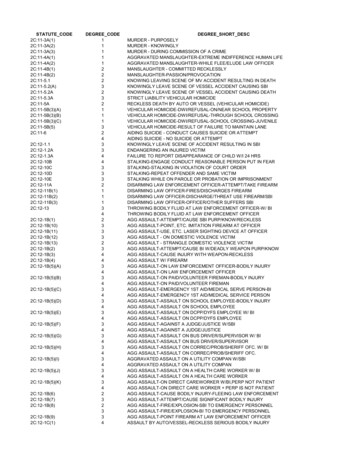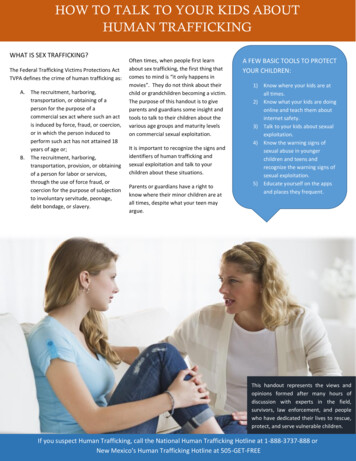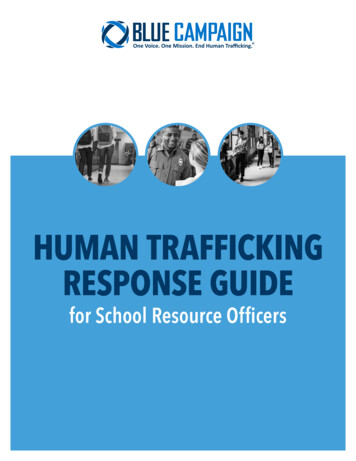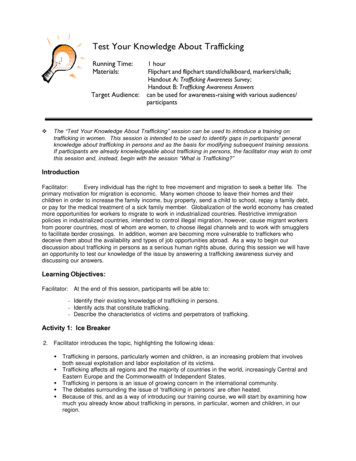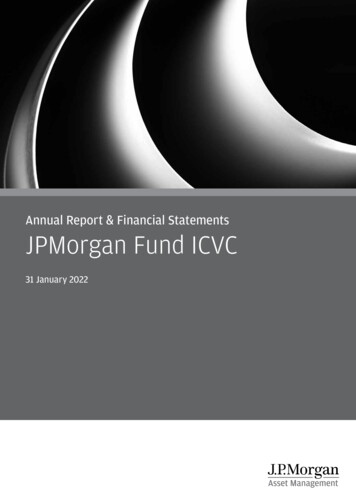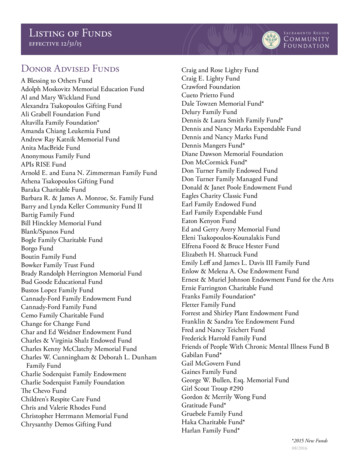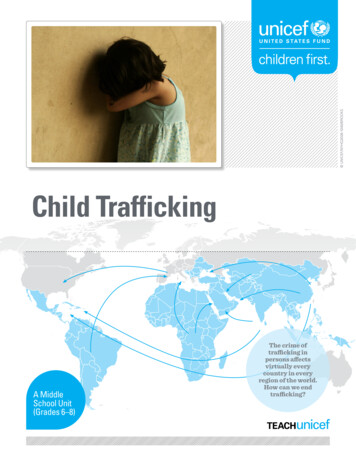
Transcription
UNICEF/NYHQ2006-1040/BrooksChild TraffickingA MiddleSchool Unit(Grades 6–8)The crime oftrafficking inpersons affectsvirtually everycountry in everyregion of the world.How can we endtrafficking?
UNICEF/UNI121792/DorminoTABLE OF CONTENTS3 Unit Overview4 Background Information7 Lesson 1: What Is Human Trafficking?14 Lesson 2: Survivor Stories20 Lesson 3: Taking Action26 Common Core State Standards and National Content Standards29 Handout 1: End Trafficking31 Handout 2: Questions for “End Trafficking”32 Handout 3: Where Was It Made?33 Handout 4: A Day in Your Life: Touched by Modern Slavery35 Handout 5: Components of Trafficking Stories36 Handout 6a–f: Role-play Sheetsi42 Handout 7: Survivor InterviewTeachUNICEF was created by the U.S. Fund for UNICEF’s Education Department. 2012, 2016Unless stated otherwise, the source for all charts, figures, maps, and statistics used in this unit is: United NationsChildren’s Fund, (UNICEF), New York. Additional sources are noted when they are required. Website addresses (URLs) areprovided throughout this unit for reference and additional research. The authors have made every effort to ensure thesesites and information are up-to-date at the time of publication, but availability in the future cannot be guaranteed.2
UNIT OVERVIEWUNIT OVERVIEWChild Trafficking is a unit of threelessons designed1. To provide students with anunderstanding of the complexityof human trafficking.2. To help students recognize and3. To educate on what UNICEF andother organizations are doingto combat human traffickingand encourage students to takeaction, both locally and globally. UNICEF/UNI88099/Crouchanalyze how human traffickingaffects children in the UnitedStates and around the world.Enduring UnderstandingHuman trafficking exists in the United States and around the world today, andit particularly affects children and youth. This is a human rights violation, it isunacceptable, and I can do something about it.Essential Questions1. What forces, from the local to the global, create a world where humantrafficking exists?2. How do vulnerability, trafficking, and exploitation affect a person?3. Why are human rights so important to keep in mind when combating anddiscussing human trafficking?4. How can advocacy and action to combat human trafficking be effective?Lesson 1: What Is Human Trafficking?Students will tap into their knowledge of human trafficking and becomeacquainted with its domestic and international dimensions, including therelationship between labor exploitation and global consumer demand.They also will begin to associate child trafficking with the violation of rightsguaranteed in the Convention on the Rights of the Child (CRC).3
UNIT OVERVIEWLesson 2: Survivor StoriesStudents will examine how children in different parts of the world becomevictims—and then survivors—of trafficking. This will include information on therisk factors that children face, the manner in which victims are exploited, andhow organizations like UNICEF are working to protect the survivors.Lesson 3: Taking ActionStudents will learn how they can take action to help end child trafficking througheducation of others, civic engagement, and support of UNICEF and its partners,while also demonstrating what they have learned about trafficking in general.Background InformationAround the WorldIn recent years, people have become more aware that children and women(and sometimes boys and men) are trafficked into the world’s commercialsex trade. But child trafficking also takes on many other forms. Children aretrafficked into labor exploitation in agriculture. They may toil in a variety ofmanufacturing industries, from large-scale sweatshops to small craft workshops.In some parts of the world, children are exploited in mining or in fisheries, or intothe militia and armed gangs in conflict zones. Girls in particular are trafficked intodomestic labor.Driven by poverty and other underlying factors, many children are moved awayfrom their homes and are exploited in the informal economy, where they areeven more difficult to trace and at risk of many forms of violence. Criminalnetworks and individuals exploit children in begging, street hawking, and otherstreet-based activities. Some children are exploited as drug couriers or dealersor in petty crime such as pickpocketing.When children are trafficked, they almost always end up in work that isdangerous to their health, safety, and morals. They may not be able to go toschool, and so they lose the opportunity to improve their lives in the future.They are often cut off from their families and at risk of sexual abuse andother forms of violence. In addition to these dangers, child trafficking violatesmany rights promised to children by the UN Convention on the Rights of theChild and other international laws, including their rights to be protected fromexploitation, to remain with their family, to go to school, to be protected fromsexual violence, and to have time to play.4
UNIT OVERVIEWIn the United StatesHuman trafficking leaves virtually no country untouched, including the UnitedStates. American citizens are trafficked right here at home; the U.S. is asource, destination, and transit point for trafficking victims. Anyone can betrafficked, regardless of citizenship, class, education, gender, or age whencoerced or enticed by false promises.In the U.S., child labor trafficking occurs in industries like restaurants, bars, hotels,and agricultural work. Child sex trafficking occurs in brothels and strip clubs, viaescort and massage services, and through pimp-controlled prostitution on thestreet. Increasingly, it is facilitated through the Internet. Approximately 244,000to 326,000 American children are at risk for commercial sexual exploitation eachyear.1 Many are runaways, homeless, or otherwise vulnerable youth.Efforts to Protect ChildrenUNICEF is the United Nations’ primary agency focusing on the rights of childrenand approaches trafficking as a serious violation of these rights. Protectingchildren from the exploitation of trafficking begins with prevention. This meansreducing the vulnerabilities that make children and families susceptible toexploitation in the first place. UNICEF, with its partners, addresses factorsthat may contribute to trafficking, including poverty and lack of educationor employment options. Active in more than 150 countries, UNICEF childprotection programs take into account all of the needs and realities thatvulnerable families and communities face. UNICEF’s efforts include elping provide sustainable economic opportunities that ensure a livingHwage for parents so that their children do not have to work to support thefamily and can attend school instead. orking with communities on changing prevalent mindsets around theWtreatment of children, through efforts such as forming local self-help groups. I mproving the quality of education, including transitional options forchildren whose education has been interrupted.In the U.S., collaboration between grassroots volunteers, survivors of humantrafficking, NGOs, policymakers, business leaders, and educators are leadingto fundamental legal, corporate, and cultural changes aimed at ending humantrafficking in all its forms. Because human trafficking is such a complex,widespread issue, addressing it requires coordination between many actors,including government, nonprofit organizations, businesses, faith-basedcommunities, law enforcement, and educators.1 Richard J. Estes and Neil Alan Weiner, The Commercial Sexual Exploitation of Children in the U.S.,Canada and Mexico, September 18, 2001 (revised February 20, 2002), 144, accessed January 8,2016, http://www.thenightministry.org/070 facts figures/030 research links/060 homeless youth/CommercialSexualExploitationofChildren.pdf.5
UNIT OVERVIEWThe exploitation of children discussedin this unit is a difficult and unsettlingtopic. Your students may not haveencountered such an issue before, buteven if they have, reasonable cautionis advised in discussing it with them.Set a tone from the beginning thatthe unit will explore some complexand potentially disturbing issues, andthat you expect the class to explorethese issues in a mature fashion.Remind the students that these crimesare happening to real children in thiscountry and around the world and that their dignity needs to be respected. UNICEF/UNI190220/BINDRASensitive Nature of IssuesAddressed in this UnitChild trafficking takes many forms, including sex trafficking, a threat thatputs hundreds of thousands of American youth at risk each year. Due to theage of the intended audience for this unit, however, you may choose to omitthis topic from classroom discussions. Prior to instruction, it is suggestedthat you review the lesson plans carefully to determine which content ismost appropriate for your particular students. If you choose to incorporatesex trafficking in your instruction, we have included several resourcesyou may wish to use; they are clearly marked as optional. Moreover, westrongly recommend that you collaborate with and gain the support of youradministration, school mental health professionals, and your students’ familiesbefore including this mature content. (For an example of the topic of sextrafficking integrated more fully into instructional materials, please see ourhigh-school unit.)6
UNICEF/UNI162954/NesbittLesson 1Lesson 1: W hat Is HumanTrafficking?OBJECTIVESStudents will efine human trafficking and explain the general characteristics of the localDand global problem. Identify and analyze how human trafficking is a violation of human rights. xplore the relationship between modern consumerism and forced laborEaround the world. I nvestigate and analyze a photo essay of children experiencing humantrafficking.MATERIALS Chart paper and markers Computer and Internet access Screen and LCD projector or interactive whiteboardAboutThisLessonTime2 days(two 45-minuteperiods)Grade LevelGrades 6–8Vocabulary Commercial sexualexploitation Convention on theRights of the Child Demand Domestic service Exploit Human trafficking Labor trafficking Pornography Profit Prostitution Sex trafficking Source,destination, andtransit point (intrafficking) Supply Treaty UNICEF7
Lesson 1PREPARATION AND SETUP Prepare copies for each student of Handouts 1–5. Prepare to display a world map (Day 2).DIRECTIONSDAY ONE:1. Introduction (20 min)a. Ask students to think about the term “human rights” and to brainstormsome examples of these rights. Then prompt students to share waysin which these rights have been violated throughout history. If no oneoffers slavery as an example, bring it up and ask what they rememberabout the topic. Tell students they will now be learning about a rightsviolation that particularly affects children and youth around the worldtoday. Introduce the topic of human trafficking and explain that it islikened to modern-day slavery. Note that it exists today in every one ofthe more than 190 countries in the world, including the United States,where it has been reported in all 50 states.b. Using chart paper, employ a K-W-L (know, want to know, learned)activity2 to better understand student background knowledge andinterests about human trafficking (i.e., students list in table formatwhat they know about the topic, what they want to know about it, andwhat they have learned about it). Keep the chart displayed so it can bereferred to throughout the unit.c. Tell students that this unit will explore cruelty toward and exploitationof children in ways that they may not have encountered before.Define exploit as “to make use of meanly or unfairly for one’s ownadvantage.”3 For example, an employer may exploit recent immigrantsby violating their rights with pay below the minimum wage and unsafeworking conditions. With limited knowledge of a new language andlegal system, immigrants may work in such jobs rather than seekjustice because it may be the only way for them to survive. Tell thestudents that when examining instances of cruelty and exploitation inthis unit, they must act maturely and recognize that these crimes arehappening to real people around the world. OPTIONAL (if you choose to include sex trafficking in your instruction):Tell students that one theme that will be examined with particularmaturity is commercial sexual exploitation of children. This is the2Donna M. Ogle, “K-W-L: A Teaching Model That Develops Active Reading of Expository Text,” ReadingTeacher 39, no. 6 (February 1986): 564–570.3Merriam-Webster.com, s.v. “Exploit,” accessed August 4, 2012, 8
Lesson 1process of profiting from exploiting children sexually, and it ofteninvolves pornography or forcing them to engage in sexual acts withothers. (The United Nations defines commercial sexual exploitation as“the obtaining of financial or other benefits through the involvement ofanother person in prostitution, sexual servitude or other kinds of sexualservices, including pornographic acts or the production of pornographicmaterials.”4) Gauge the students’ response and answer questions ifthey have any. Insist that the students address this sensitive topic withthe utmost of maturity and seriousness.2. Reading Activity and Review (10–15 min): Distribute Handout 1: EndTrafficking and Handout 2: Questions for “End Trafficking” and have thestudents complete the reading activity. When they finish, review anddiscuss together:1. What is the definition of human trafficking? Answer: A practice thatsubjects children, women, and men to force, fraud, or coercion for thepurpose of commercial sexual exploitation or forced labor.Please return to the“Sensitive Nature ofIssues Explored in thisUnit” heading in theBackground section forour advice regardingthe teaching of theaforementioned topics.2. What are some forms that labor trafficking can take? Answer: Work in restaurants, bars, hotels, agriculture, construction, ortraveling sales crews. OPTIONAL (if you choose to include sex trafficking in your instruction):Go over the forms of sex trafficking listed. Indicate that they are alsoknown collectively as “commercial sexual exploitation.” Indicate that the following forms of trafficking also affect millions ofchildren around the world: Child soldiers Child begging Forced marriage3. Where does human trafficking occur in the United States? Answer:Human trafficking has been reported in all 50 states, with particularlyhigh rates in California, Texas, Florida, and New York.Discuss: Why do you think trafficking rates are particularly high in thosefour states? Answer: They are the four largest states in population,and they have large numbers of immigrants (though it is not justimmigrants who can be trafficking victims).4United Nations Office on Drugs and Crime (UNODC), Model Law against Trafficking in Persons,accessed August 4, 2012, NODC Model Lawon Trafficking in Persons.pdf.9
Lesson 1 Definitions of terms5 Source: Country, town, or village or other origin point of thetrafficked individual Destination: Place where the trafficked individual ends up inexploitation Transit point: Point on a trafficking route between the sourceand the destination4. How many children are estimated to be victims of human trafficking?Is any type of person not at risk of being trafficked? Answer: TheInternational Labor Organization estimates that there are 5.5 millionchild victims of trafficking. Anyone can be trafficked, regardless of class,education, gender, or age when coerced or lured by false promises.Discuss: Ask the students if they are surprised that being of a higher incomelevel (i.e., class) does not necessarily protect someone from beingtrafficked. sk them if they think that being poor automatically puts someoneAat risk. ell them that poverty, while important, is only one of manyTrisk factors, which can include lack of education or economicopportunity; breakdown in the family due to separation,displacement, disease, or death; and societal discriminationbased on class, religion, or ethnicity. Reiterate that anyone can betrafficked, regardless of class, education, gender, or age.5. Name one way UNICEF helps fight child trafficking that you think youunderstand well. Give another example that you do not fully understand.Start the discussion by sharing UNICEF’s message about what it does: The United Nations Children’s Fund (UNICEF) works in more than 190countries and territories to help get kids what they need to survive andgrow into happy and healthy adults. UNICEF helps to supply things likemedicines and vaccinations, clean drinking water, health-giving foods,and shelter. It also helps to build schools and provide school supplies.It responds with emergency relief when wars take place or whendisasters like earthquakes and floods occur. Then address students’ contributions to this item from the handout,which will come from the second page and will vary. Explain theexamples that students do not fully understand; for those needing moreexplanation, place them in the “W” column of the K-W-L chart.5Adapted from International Labour Office (ILO), International Programme on the Elimination of ChildLabour (IPEC), Training Manual to Fight Trafficking in Children for Labour, Sexual and Other Forms ofExploitation, Textbook 1: Understanding Child Trafficking (Geneva: International Labour Organization,2009), 22, accessed August 5, 2012, http://www.unicef.org/protection/Textbook 1.pdf.10
Lesson 13. Preparation for the Activity “Understanding My Slavery Footprint”(5–10 min)a. Supply and Demand: Tell students that trafficking impacts everyone,victims and nonvictims alike. Ask the students to think of somethingthey have purchased recently at a store. Point out that when they andothers purchased that item, they created a demand for that item. Themore people who went to the store and bought that item, the greaterthe demand became for that item, causing the store to increasetheir supply of that item to meet the demand. Ask the students ifprice matters when they make purchases. Indicate that we wantthe products we buy to be as cheap or inexpensive as possible incomparison with other similar products so we feel like we’re gettingthe best value. This causes companies to produce products at thelowest cost possible. Normally, this can be achieved in regular and legalways. But when law enforcement is weak, a producer may be temptedto pay workers inadequate wages or no wages at all. The producer alsomay be tempted to employ traffickers to provide these workers.b. Explain to the students that they will be given a homework assignmentthat will help them begin to think about how they and their familiesand communities may, without even knowing it, be helping to fuelthe supply of trafficking victims by creating demand for certain goods.Distribute Handout 3: Where Was It Made? and review the directions;assign it as homework.c. Review with the students the main points from the day’s session(definition of human trafficking; labor and sex trafficking being the twomain forms; the geographic elements to trafficking; and the economicconcepts of supply, demand, and profit). Note these on the K-W-Lchart. End with a preview of tomorrow’s session.DAY TWO:1. Opening (5–10 min): Review the previous day’s session, using the K-W-Lchart. Review the part of Handout 1 that says that trafficking victimssuffer from physical, emotional, and sexual abuse, and rarely have accessto education or to health care. Tell students that these are rights thatchildren lose when they are victims of trafficking. Emphasize that childtrafficking is a human rights violation, as made clear in the Convention onthe Rights of the Child (CRC). Mention that the CRC is the most widelyaccepted treaty (or contract in writing between two or more politicalauthorities6) in the world, which puts into international law basic standardsin health, education, protection, and social services for children. It is at6Merriam-Webster.com, s.v. “Treaty,” accessed August 5, 2012, 1
Lesson 1the foundation of UNICEF’s work in all of its core areas, including childprotection (which includes combating child trafficking). OPTIONAL Show video, “Overview: Convention on the Rights of theChild,” at ts-child, askingthe class to note examples of the rights the CRC protects. Discuss.2. Understanding Our Slavery Footprint (25–30 min):a. Have the students take out their homework (Handout 3). Ask avolunteer to tell the class what his or her first item is and where itwas made. Locate the country on a displayed map. Note the continentwhere the country is located. Is the class familiar with this country?Was anyone in the class born in this country, or has anyone traveledto this country? Does anyone in the class have a friend or relative wholives in this country? Solicit several such examples from the class; findeach country on the map, and ask the same questions. The goal is toget examples of several different types of products from a variety ofcountries, including the United States.b. Introduce the concept of a footprint. Besides the tracks left by feet,indicate that the dictionary defines footprint as “the area on a surfacecovered by something.”7 A specific use of that meaning of footprintis employed in the environmental term carbon footprint, or “theamount of greenhouse gases and specifically carbon dioxide emittedby something (as a person’s activities or a product’s manufacture andtransport) during a given period.”8 Tell the students that this activityexamines our slavery footprint, as individuals and as a society.Learn more about theCRC at hts-crc.The U.S. has not ratifiedthe Convention as ofthe development ofthis unit. If you areinterested in ways totake action with yourstudents, visit tschild and the Campaignfor U.S. Ratification ofthe Convention on theRights of the Child atchildrightscampaign.org.c. Either distribute copies of Handout 4: A Day in Your Life: Touched byModern Slavery or display it on a screen or interactive whiteboard. Readit carefully together as a class, contextualizing and modifying for the ageand maturity level of your audience as you go. Note which products andcountries or regions were represented in their homework assignment.d. Lead a discussion centered on these prompts: Describe our slavery footprint. What did you learn from this activity? ow does what you learned make you feel? Explore issues ofHfairness and justice. ill this make you think more about where your products comeWfrom?7Merriam-Webster.com, s.v. “Footprint,” accessed August 5, 2012, t.8Merriam-Webster.com, s.v. “Carbon footprint,” accessed August 5, 2012, 0footprint.12
Lesson 1 I n our economy where products move easily around the globe, itis almost inevitable that our lives will be touched by conditions likeslavery in some way. Do you think this is acceptable? What can wedo to change that reality?e. Solidify the connection between forced labor and human trafficking. Tellthe students that many of the individuals involved in these situationsare children and victims of human trafficking. Indicate that whenpeople are recruited, transported, transferred, harbored, or receivedfor the purpose of exploitation (such as the situations examined in thisactivity), they are being trafficked.9f. OPTIONAL: Use computers to access a United States Departmentof Labor report at dol.gov/ilab/reports/child-labor/list-of-goods anddetermine whether the students’ products and countries are on the listof goods produced by child labor or forced labor.3. Closure (5 min): End the lesson with discussion, journaling, or anotherway to capture the students’ thoughts on the issues presented thus far.Add to the K-W-L chart. Tell students that in the next lesson, they will learnmore about human trafficking in the United States and around the worldand what is being done by UNICEF and other organizations to combattrafficking and to help its survivors. They will do this by “meeting” a few ofthose survivors.Extension Activities ave students research one of the companies from their assignment andHwrite a report on what, if anything, the company is doing to make sure thatnone of their products are made using human slaves. They can researchthe country where the product is made and report on what laws are inplace in that country to prevent human trafficking; to prosecute traffickers;and to protect vulnerable men, women, and children from becomingvictims of trafficking. ave students write letters to local shop owners to discourage them fromHcarrying certain products that have a heavy slavery footprint. ncourage students to launch or join a campaign to raise local awarenessEabout everyone’s slavery footprint and products that involve slave labor.9ILO, IPEC, 14.13
UNICEF/UNI127306/NooraniLesson 2Lesson 2: Survivor StoriesOBJECTIVESStudents will xplain the general components of a trafficking situation, including riskEfactors and vulnerability, exploitation, rescue, and rehabilitation. ngage in a role-play of a real-life trafficking situation to convey theEcomplexities of trafficking situations.MATERIALS Computers and Internet access Screen and LCD projector or interactive whiteboardAboutThisLessonTime2 days(two 45-minuteperiods)Grade LevelGrades 6–8Vocabulary Coerce Coercion Fraud Rehabilitation VulnerablePREPARATION AND SETUP Prepare copies for each student of Handouts 5 and 7 repare copies of Handouts 6a-f (Trafficking Stories) so that each studentPhas one story to read14
Lesson 2DIRECTIONSDAY ONE:1. Re-engage with Photos (5 min): Find Bangladesh on the map. Ask ifany students had products from the previous session that came fromBangladesh. Then show students the “Child Labor in Bangladesh” photoessay at unicef.org/bangladesh/6505.html; discuss. Add resulting ideas tothe K-W-L chart. Address students’ concerns before moving on.2. Learning Survivor Stories (30 min)a. Tell students that now that they have a basic idea of what humantrafficking is, they will begin to learn about real stories of survivorsof child trafficking from around the world: how they were vulnerableto trafficking, how they were exploited, how they were rescued, andthe kinds of things being done by numerous organizations around theworld to help them.b. Define the following terms used in the activity: Coercion: The act of using force or threat to achieve something raud: The act of using falsehoods to get something from someoneFelse Rehabilitation: The process of being restored to health and well-being Vulnerable: Open to being harmed, physically or emotionallyc. Distribute Handout 5: Components of Trafficking Stories and displayit on the screen or interactive whiteboard. Have students read thecolumn headers on their own or guide them through them. Explain anddiscuss; check for understanding.d. Tell students that they will now hear a survivor story read aloud. Asthey listen, they are to try to identify the trafficking components ofthe story and record them in the appropriate column on the first lineof the chart in Handout 5. Read the following story, pacing yourselfintentionally to allow the important elements to make their impact onstudents: My name is Natalia and I was born and raised in a small village inGhana, in West Africa. My family was struggling to pay the school feesfor their children’s education and they welcomed the opportunity forme to receive an education in the United States. Shortly after I arrived in the U.S., the father of the family I was livingwith began to physically [and sexually] abuse me. I was constantlyafraid. For the next six years I was forced to clean the house, washclothes, cook, and care for their three children, often working 18 hoursa day while receiving no form of payment. I was never allowed toenroll in school as the family had promised, go outside, or even use15
Lesson 2the phone. One day, after I was severely beaten, I was able to runaway from the home and a neighbor called the police. I was then takento a local hospital for medical care. They called the National HumanTrafficking Resource Center and referred me to Polaris Project whoimmediately coordinated emergency services, including clothing, asafe shelter, counseling, emotional support, and case management.Within a month, I was enrolled in school as I had always dreamed. Iam now living in transitional housing and volunteering at a local animalrescue shelter, participating in a weekly poetry workshop, and pursuingmy education to become a nurse.10 After reading the story, review the trafficking components with theclass and check for understanding. Lead a discussion using some or allof the following questions: hat are some specific words that describe how this child feltWthroughout the trafficking experience? ow do you think the experience affected this child’s sense of whoHshe is or her relationships with others? hat lasting effects might such an experience have on this child,Weven after rescue and rehabilitation? What do you think her dreams and goals are for the future? Is there anything that you would like to ask this child?e. Provide each student with a trafficking story to read (see Handouts6a–f; note that Handout 6f, should you choose to include it, involvesattempted sexual exploitation). Indicate that they are based onthe stories of real survivors of child trafficking, but the names andsome of the details (including the country where the person wasborn or trafficked) may have been changed in order to protect thesurvivors. Instruct students to
What forces, from the local to the global, create a world where human trafficking exists? 2. How do vulnerability, trafficking, and exploitation affect a person? 3. Why are human rights so important to keep in mind when combating and discussing human trafficking? 4. How can advocacy and action to combat human trafficking be effective?
